Report: Health Education, Barriers, and Initiatives in the NHS
VerifiedAdded on 2023/01/12
|15
|5104
|88
Report
AI Summary
This report provides a comprehensive analysis of health education within the context of the NHS, exploring various factors influencing health status, such as socio-economic factors, gender, culture, and lifestyle. It delves into the barriers service users face when accessing healthcare, including physical and mental disabilities, cultural and communication barriers, and financial constraints. The report also examines the relationship between health beliefs and illness, discussing attribution theory, health locus of control, and self-efficacy. Furthermore, it compares and contrasts health education and health promotion, highlighting strategies for health improvement and the role of theoretical models in local health education campaigns. Finally, the report outlines the need for a health education initiative based on local demographic data and a relevant theoretical model, culminating in a detailed plan for a local health education initiative to address a current health issue.
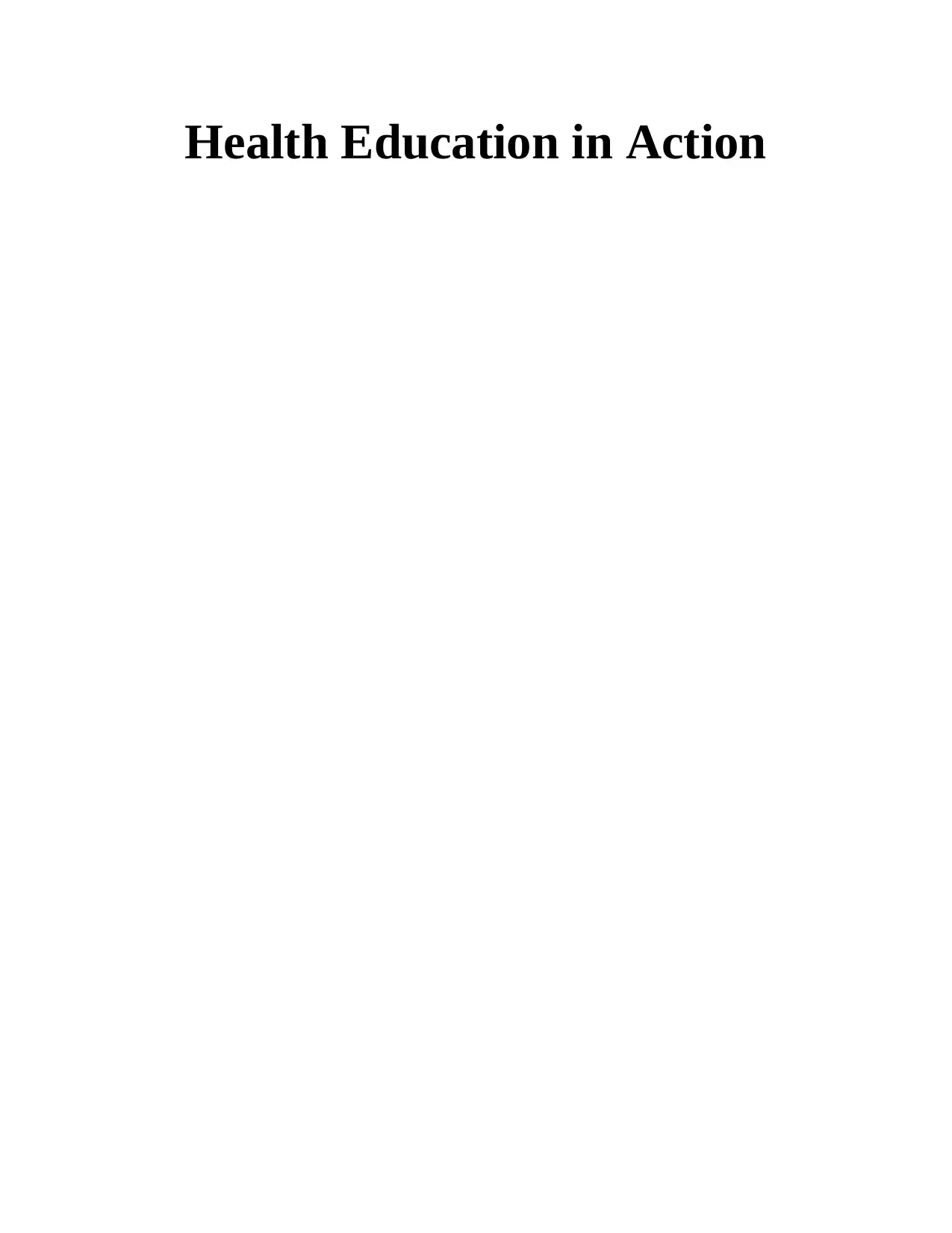
Health Education in Action
Paraphrase This Document
Need a fresh take? Get an instant paraphrase of this document with our AI Paraphraser
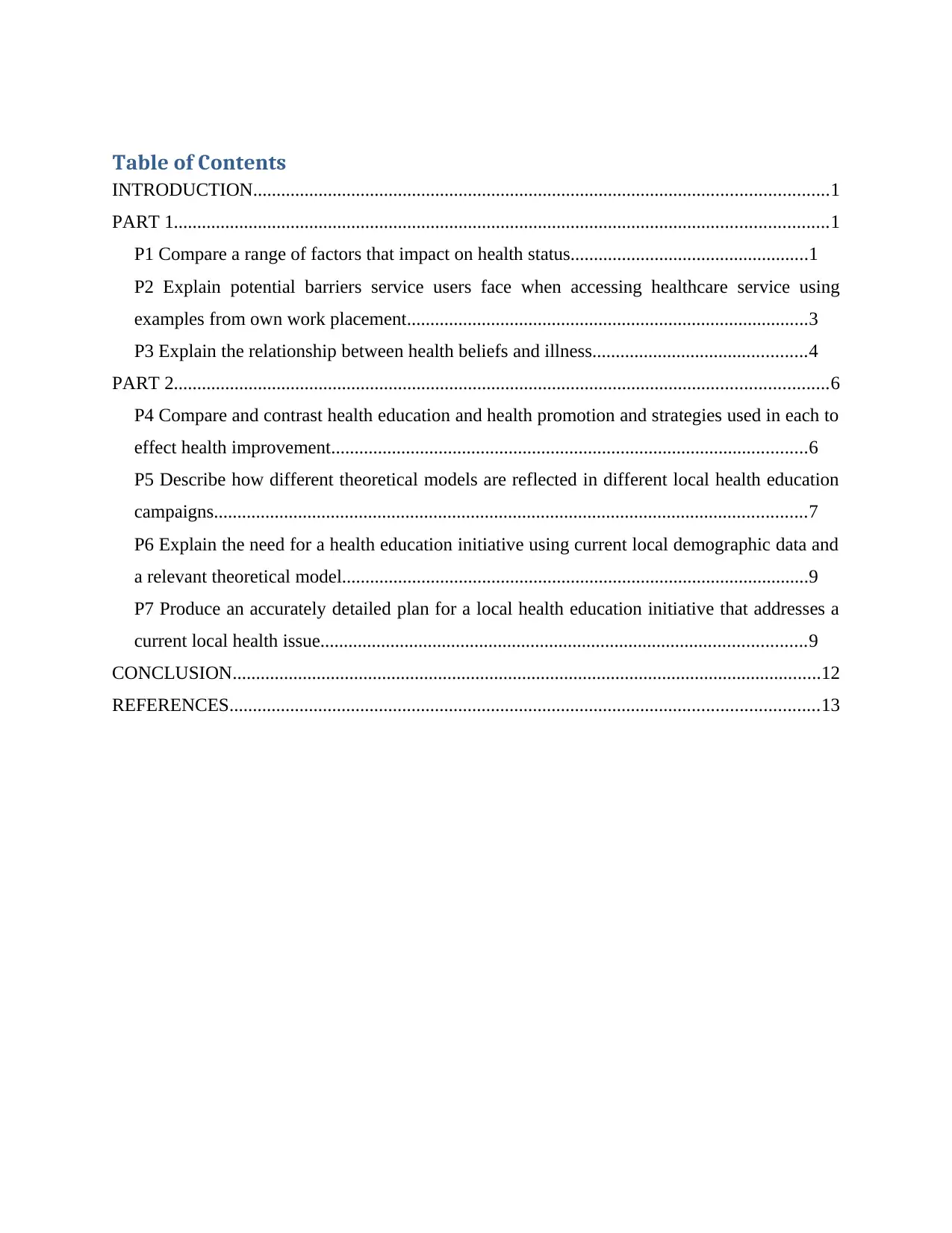
Table of Contents
INTRODUCTION...........................................................................................................................1
PART 1............................................................................................................................................1
P1 Compare a range of factors that impact on health status...................................................1
P2 Explain potential barriers service users face when accessing healthcare service using
examples from own work placement......................................................................................3
P3 Explain the relationship between health beliefs and illness..............................................4
PART 2............................................................................................................................................6
P4 Compare and contrast health education and health promotion and strategies used in each to
effect health improvement......................................................................................................6
P5 Describe how different theoretical models are reflected in different local health education
campaigns...............................................................................................................................7
P6 Explain the need for a health education initiative using current local demographic data and
a relevant theoretical model....................................................................................................9
P7 Produce an accurately detailed plan for a local health education initiative that addresses a
current local health issue........................................................................................................9
CONCLUSION..............................................................................................................................12
REFERENCES..............................................................................................................................13
INTRODUCTION...........................................................................................................................1
PART 1............................................................................................................................................1
P1 Compare a range of factors that impact on health status...................................................1
P2 Explain potential barriers service users face when accessing healthcare service using
examples from own work placement......................................................................................3
P3 Explain the relationship between health beliefs and illness..............................................4
PART 2............................................................................................................................................6
P4 Compare and contrast health education and health promotion and strategies used in each to
effect health improvement......................................................................................................6
P5 Describe how different theoretical models are reflected in different local health education
campaigns...............................................................................................................................7
P6 Explain the need for a health education initiative using current local demographic data and
a relevant theoretical model....................................................................................................9
P7 Produce an accurately detailed plan for a local health education initiative that addresses a
current local health issue........................................................................................................9
CONCLUSION..............................................................................................................................12
REFERENCES..............................................................................................................................13
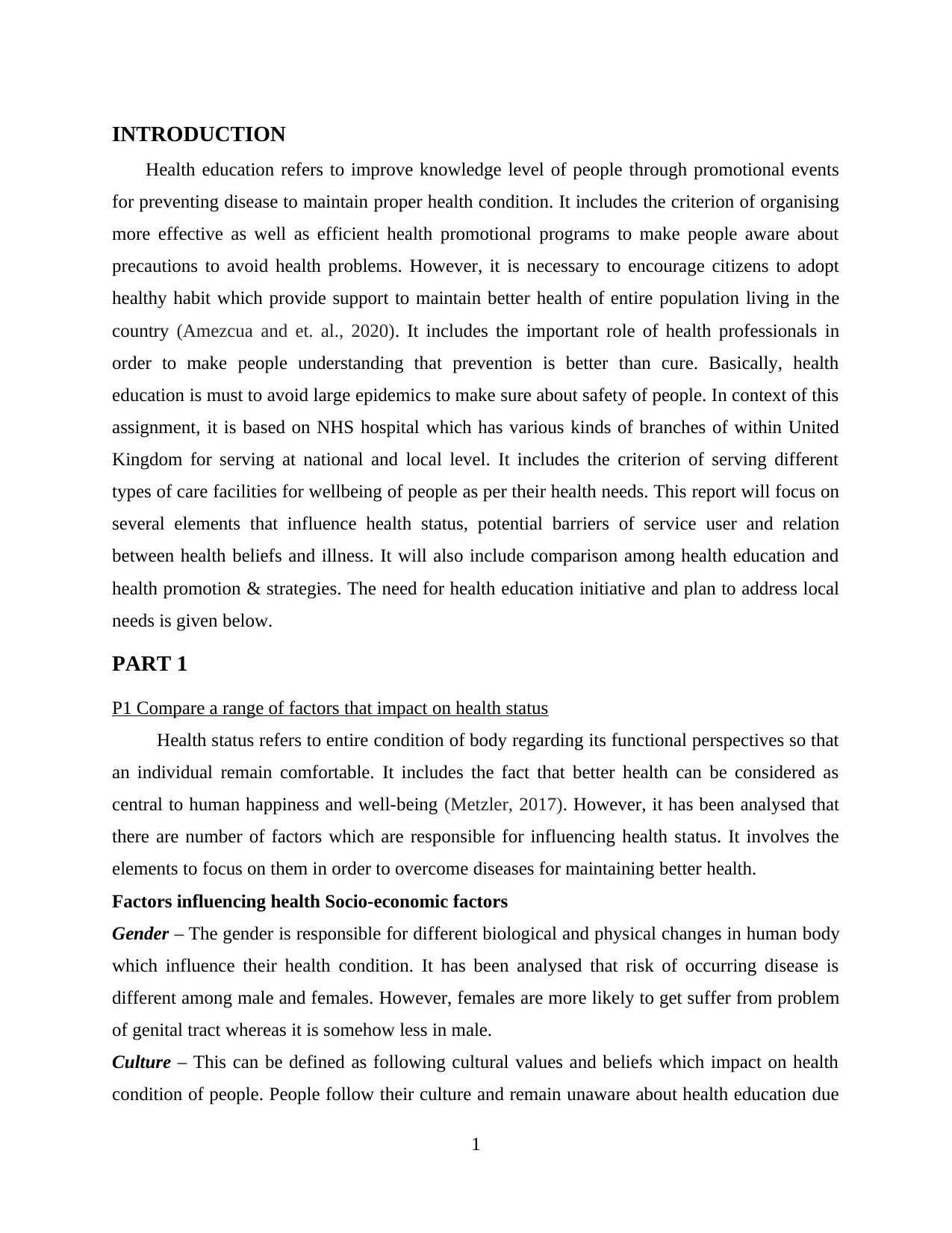
INTRODUCTION
Health education refers to improve knowledge level of people through promotional events
for preventing disease to maintain proper health condition. It includes the criterion of organising
more effective as well as efficient health promotional programs to make people aware about
precautions to avoid health problems. However, it is necessary to encourage citizens to adopt
healthy habit which provide support to maintain better health of entire population living in the
country (Amezcua and et. al., 2020). It includes the important role of health professionals in
order to make people understanding that prevention is better than cure. Basically, health
education is must to avoid large epidemics to make sure about safety of people. In context of this
assignment, it is based on NHS hospital which has various kinds of branches of within United
Kingdom for serving at national and local level. It includes the criterion of serving different
types of care facilities for wellbeing of people as per their health needs. This report will focus on
several elements that influence health status, potential barriers of service user and relation
between health beliefs and illness. It will also include comparison among health education and
health promotion & strategies. The need for health education initiative and plan to address local
needs is given below.
PART 1
P1 Compare a range of factors that impact on health status
Health status refers to entire condition of body regarding its functional perspectives so that
an individual remain comfortable. It includes the fact that better health can be considered as
central to human happiness and well-being (Metzler, 2017). However, it has been analysed that
there are number of factors which are responsible for influencing health status. It involves the
elements to focus on them in order to overcome diseases for maintaining better health.
Factors influencing health Socio-economic factors
Gender – The gender is responsible for different biological and physical changes in human body
which influence their health condition. It has been analysed that risk of occurring disease is
different among male and females. However, females are more likely to get suffer from problem
of genital tract whereas it is somehow less in male.
Culture – This can be defined as following cultural values and beliefs which impact on health
condition of people. People follow their culture and remain unaware about health education due
1
Health education refers to improve knowledge level of people through promotional events
for preventing disease to maintain proper health condition. It includes the criterion of organising
more effective as well as efficient health promotional programs to make people aware about
precautions to avoid health problems. However, it is necessary to encourage citizens to adopt
healthy habit which provide support to maintain better health of entire population living in the
country (Amezcua and et. al., 2020). It includes the important role of health professionals in
order to make people understanding that prevention is better than cure. Basically, health
education is must to avoid large epidemics to make sure about safety of people. In context of this
assignment, it is based on NHS hospital which has various kinds of branches of within United
Kingdom for serving at national and local level. It includes the criterion of serving different
types of care facilities for wellbeing of people as per their health needs. This report will focus on
several elements that influence health status, potential barriers of service user and relation
between health beliefs and illness. It will also include comparison among health education and
health promotion & strategies. The need for health education initiative and plan to address local
needs is given below.
PART 1
P1 Compare a range of factors that impact on health status
Health status refers to entire condition of body regarding its functional perspectives so that
an individual remain comfortable. It includes the fact that better health can be considered as
central to human happiness and well-being (Metzler, 2017). However, it has been analysed that
there are number of factors which are responsible for influencing health status. It involves the
elements to focus on them in order to overcome diseases for maintaining better health.
Factors influencing health Socio-economic factors
Gender – The gender is responsible for different biological and physical changes in human body
which influence their health condition. It has been analysed that risk of occurring disease is
different among male and females. However, females are more likely to get suffer from problem
of genital tract whereas it is somehow less in male.
Culture – This can be defined as following cultural values and beliefs which impact on health
condition of people. People follow their culture and remain unaware about health education due
1
⊘ This is a preview!⊘
Do you want full access?
Subscribe today to unlock all pages.

Trusted by 1+ million students worldwide
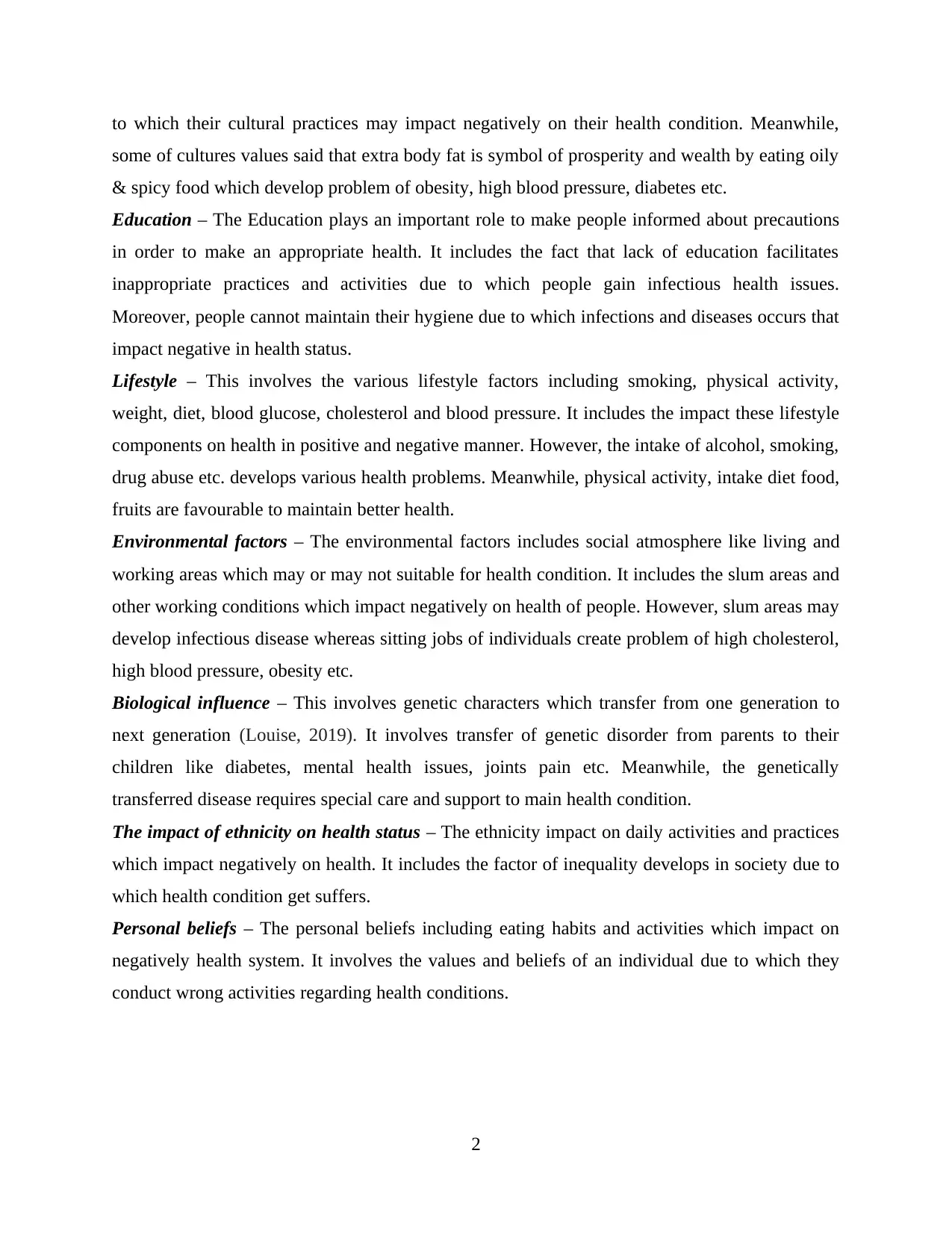
to which their cultural practices may impact negatively on their health condition. Meanwhile,
some of cultures values said that extra body fat is symbol of prosperity and wealth by eating oily
& spicy food which develop problem of obesity, high blood pressure, diabetes etc.
Education – The Education plays an important role to make people informed about precautions
in order to make an appropriate health. It includes the fact that lack of education facilitates
inappropriate practices and activities due to which people gain infectious health issues.
Moreover, people cannot maintain their hygiene due to which infections and diseases occurs that
impact negative in health status.
Lifestyle – This involves the various lifestyle factors including smoking, physical activity,
weight, diet, blood glucose, cholesterol and blood pressure. It includes the impact these lifestyle
components on health in positive and negative manner. However, the intake of alcohol, smoking,
drug abuse etc. develops various health problems. Meanwhile, physical activity, intake diet food,
fruits are favourable to maintain better health.
Environmental factors – The environmental factors includes social atmosphere like living and
working areas which may or may not suitable for health condition. It includes the slum areas and
other working conditions which impact negatively on health of people. However, slum areas may
develop infectious disease whereas sitting jobs of individuals create problem of high cholesterol,
high blood pressure, obesity etc.
Biological influence – This involves genetic characters which transfer from one generation to
next generation (Louise, 2019). It involves transfer of genetic disorder from parents to their
children like diabetes, mental health issues, joints pain etc. Meanwhile, the genetically
transferred disease requires special care and support to main health condition.
The impact of ethnicity on health status – The ethnicity impact on daily activities and practices
which impact negatively on health. It includes the factor of inequality develops in society due to
which health condition get suffers.
Personal beliefs – The personal beliefs including eating habits and activities which impact on
negatively health system. It involves the values and beliefs of an individual due to which they
conduct wrong activities regarding health conditions.
2
some of cultures values said that extra body fat is symbol of prosperity and wealth by eating oily
& spicy food which develop problem of obesity, high blood pressure, diabetes etc.
Education – The Education plays an important role to make people informed about precautions
in order to make an appropriate health. It includes the fact that lack of education facilitates
inappropriate practices and activities due to which people gain infectious health issues.
Moreover, people cannot maintain their hygiene due to which infections and diseases occurs that
impact negative in health status.
Lifestyle – This involves the various lifestyle factors including smoking, physical activity,
weight, diet, blood glucose, cholesterol and blood pressure. It includes the impact these lifestyle
components on health in positive and negative manner. However, the intake of alcohol, smoking,
drug abuse etc. develops various health problems. Meanwhile, physical activity, intake diet food,
fruits are favourable to maintain better health.
Environmental factors – The environmental factors includes social atmosphere like living and
working areas which may or may not suitable for health condition. It includes the slum areas and
other working conditions which impact negatively on health of people. However, slum areas may
develop infectious disease whereas sitting jobs of individuals create problem of high cholesterol,
high blood pressure, obesity etc.
Biological influence – This involves genetic characters which transfer from one generation to
next generation (Louise, 2019). It involves transfer of genetic disorder from parents to their
children like diabetes, mental health issues, joints pain etc. Meanwhile, the genetically
transferred disease requires special care and support to main health condition.
The impact of ethnicity on health status – The ethnicity impact on daily activities and practices
which impact negatively on health. It includes the factor of inequality develops in society due to
which health condition get suffers.
Personal beliefs – The personal beliefs including eating habits and activities which impact on
negatively health system. It involves the values and beliefs of an individual due to which they
conduct wrong activities regarding health conditions.
2
Paraphrase This Document
Need a fresh take? Get an instant paraphrase of this document with our AI Paraphraser
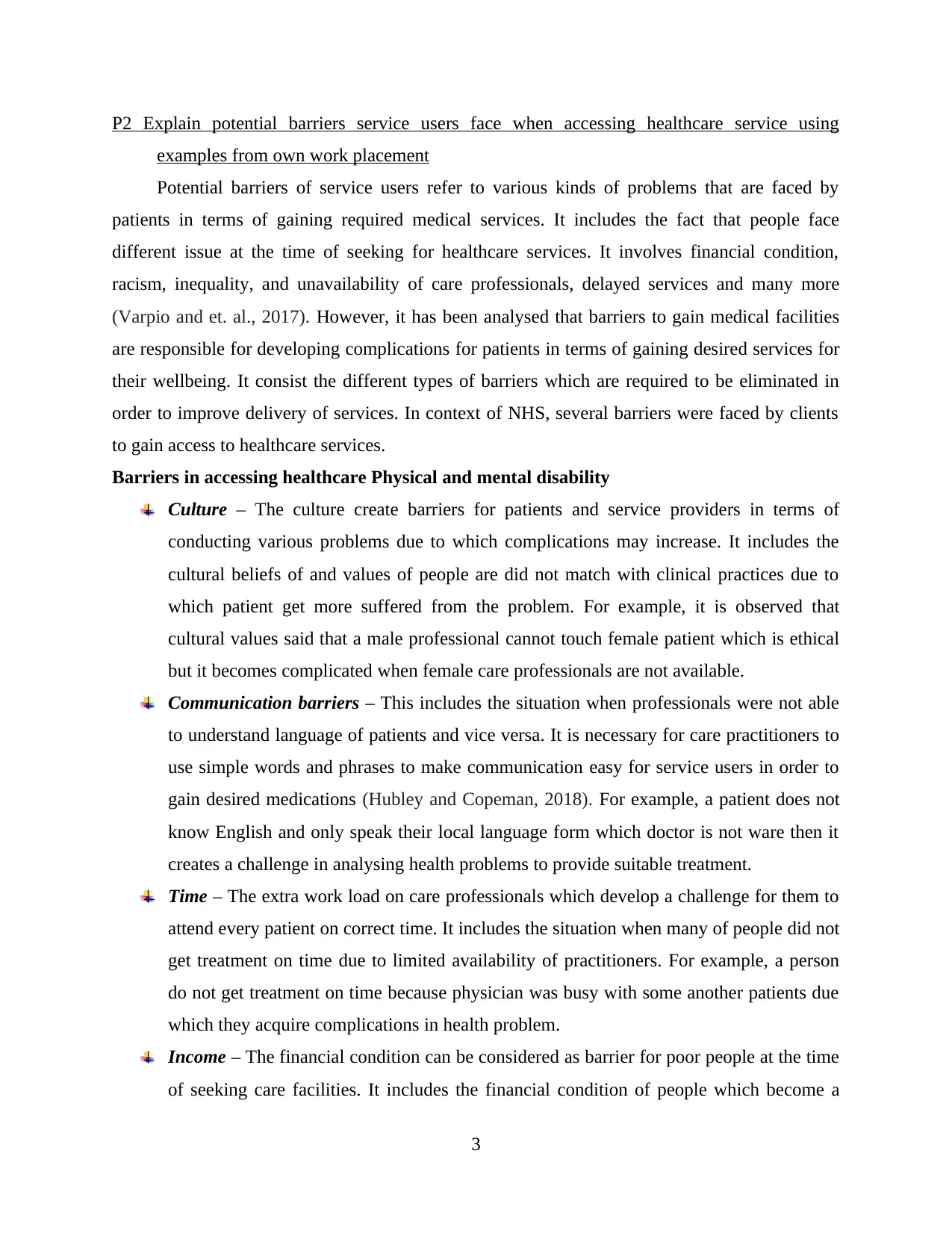
P2 Explain potential barriers service users face when accessing healthcare service using
examples from own work placement
Potential barriers of service users refer to various kinds of problems that are faced by
patients in terms of gaining required medical services. It includes the fact that people face
different issue at the time of seeking for healthcare services. It involves financial condition,
racism, inequality, and unavailability of care professionals, delayed services and many more
(Varpio and et. al., 2017). However, it has been analysed that barriers to gain medical facilities
are responsible for developing complications for patients in terms of gaining desired services for
their wellbeing. It consist the different types of barriers which are required to be eliminated in
order to improve delivery of services. In context of NHS, several barriers were faced by clients
to gain access to healthcare services.
Barriers in accessing healthcare Physical and mental disability
Culture – The culture create barriers for patients and service providers in terms of
conducting various problems due to which complications may increase. It includes the
cultural beliefs of and values of people are did not match with clinical practices due to
which patient get more suffered from the problem. For example, it is observed that
cultural values said that a male professional cannot touch female patient which is ethical
but it becomes complicated when female care professionals are not available.
Communication barriers – This includes the situation when professionals were not able
to understand language of patients and vice versa. It is necessary for care practitioners to
use simple words and phrases to make communication easy for service users in order to
gain desired medications (Hubley and Copeman, 2018). For example, a patient does not
know English and only speak their local language form which doctor is not ware then it
creates a challenge in analysing health problems to provide suitable treatment.
Time – The extra work load on care professionals which develop a challenge for them to
attend every patient on correct time. It includes the situation when many of people did not
get treatment on time due to limited availability of practitioners. For example, a person
do not get treatment on time because physician was busy with some another patients due
which they acquire complications in health problem.
Income – The financial condition can be considered as barrier for poor people at the time
of seeking care facilities. It includes the financial condition of people which become a
3
examples from own work placement
Potential barriers of service users refer to various kinds of problems that are faced by
patients in terms of gaining required medical services. It includes the fact that people face
different issue at the time of seeking for healthcare services. It involves financial condition,
racism, inequality, and unavailability of care professionals, delayed services and many more
(Varpio and et. al., 2017). However, it has been analysed that barriers to gain medical facilities
are responsible for developing complications for patients in terms of gaining desired services for
their wellbeing. It consist the different types of barriers which are required to be eliminated in
order to improve delivery of services. In context of NHS, several barriers were faced by clients
to gain access to healthcare services.
Barriers in accessing healthcare Physical and mental disability
Culture – The culture create barriers for patients and service providers in terms of
conducting various problems due to which complications may increase. It includes the
cultural beliefs of and values of people are did not match with clinical practices due to
which patient get more suffered from the problem. For example, it is observed that
cultural values said that a male professional cannot touch female patient which is ethical
but it becomes complicated when female care professionals are not available.
Communication barriers – This includes the situation when professionals were not able
to understand language of patients and vice versa. It is necessary for care practitioners to
use simple words and phrases to make communication easy for service users in order to
gain desired medications (Hubley and Copeman, 2018). For example, a patient does not
know English and only speak their local language form which doctor is not ware then it
creates a challenge in analysing health problems to provide suitable treatment.
Time – The extra work load on care professionals which develop a challenge for them to
attend every patient on correct time. It includes the situation when many of people did not
get treatment on time due to limited availability of practitioners. For example, a person
do not get treatment on time because physician was busy with some another patients due
which they acquire complications in health problem.
Income – The financial condition can be considered as barrier for poor people at the time
of seeking care facilities. It includes the financial condition of people which become a
3
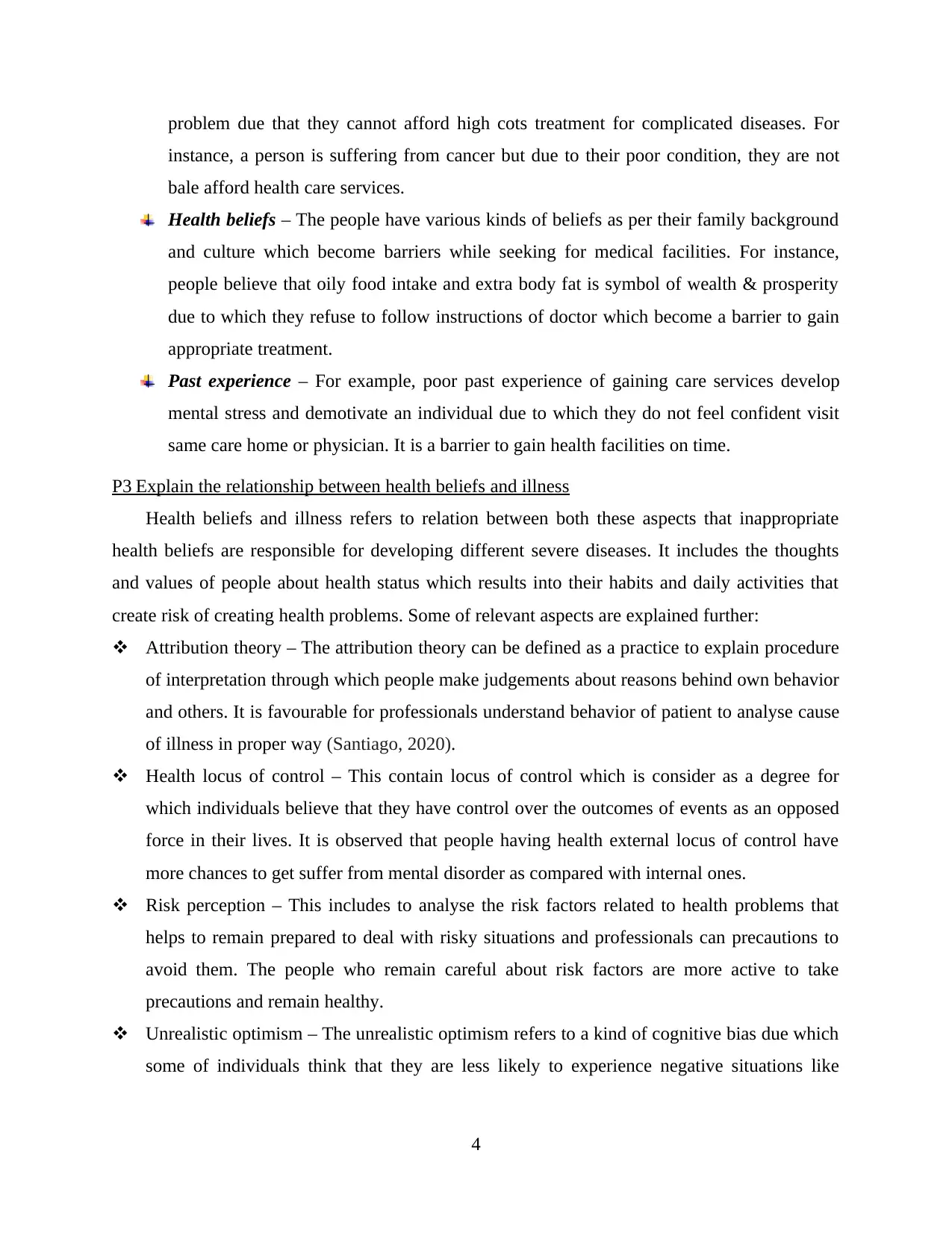
problem due that they cannot afford high cots treatment for complicated diseases. For
instance, a person is suffering from cancer but due to their poor condition, they are not
bale afford health care services.
Health beliefs – The people have various kinds of beliefs as per their family background
and culture which become barriers while seeking for medical facilities. For instance,
people believe that oily food intake and extra body fat is symbol of wealth & prosperity
due to which they refuse to follow instructions of doctor which become a barrier to gain
appropriate treatment.
Past experience – For example, poor past experience of gaining care services develop
mental stress and demotivate an individual due to which they do not feel confident visit
same care home or physician. It is a barrier to gain health facilities on time.
P3 Explain the relationship between health beliefs and illness
Health beliefs and illness refers to relation between both these aspects that inappropriate
health beliefs are responsible for developing different severe diseases. It includes the thoughts
and values of people about health status which results into their habits and daily activities that
create risk of creating health problems. Some of relevant aspects are explained further:
Attribution theory – The attribution theory can be defined as a practice to explain procedure
of interpretation through which people make judgements about reasons behind own behavior
and others. It is favourable for professionals understand behavior of patient to analyse cause
of illness in proper way (Santiago, 2020).
Health locus of control – This contain locus of control which is consider as a degree for
which individuals believe that they have control over the outcomes of events as an opposed
force in their lives. It is observed that people having health external locus of control have
more chances to get suffer from mental disorder as compared with internal ones.
Risk perception – This includes to analyse the risk factors related to health problems that
helps to remain prepared to deal with risky situations and professionals can precautions to
avoid them. The people who remain careful about risk factors are more active to take
precautions and remain healthy.
Unrealistic optimism – The unrealistic optimism refers to a kind of cognitive bias due which
some of individuals think that they are less likely to experience negative situations like
4
instance, a person is suffering from cancer but due to their poor condition, they are not
bale afford health care services.
Health beliefs – The people have various kinds of beliefs as per their family background
and culture which become barriers while seeking for medical facilities. For instance,
people believe that oily food intake and extra body fat is symbol of wealth & prosperity
due to which they refuse to follow instructions of doctor which become a barrier to gain
appropriate treatment.
Past experience – For example, poor past experience of gaining care services develop
mental stress and demotivate an individual due to which they do not feel confident visit
same care home or physician. It is a barrier to gain health facilities on time.
P3 Explain the relationship between health beliefs and illness
Health beliefs and illness refers to relation between both these aspects that inappropriate
health beliefs are responsible for developing different severe diseases. It includes the thoughts
and values of people about health status which results into their habits and daily activities that
create risk of creating health problems. Some of relevant aspects are explained further:
Attribution theory – The attribution theory can be defined as a practice to explain procedure
of interpretation through which people make judgements about reasons behind own behavior
and others. It is favourable for professionals understand behavior of patient to analyse cause
of illness in proper way (Santiago, 2020).
Health locus of control – This contain locus of control which is consider as a degree for
which individuals believe that they have control over the outcomes of events as an opposed
force in their lives. It is observed that people having health external locus of control have
more chances to get suffer from mental disorder as compared with internal ones.
Risk perception – This includes to analyse the risk factors related to health problems that
helps to remain prepared to deal with risky situations and professionals can precautions to
avoid them. The people who remain careful about risk factors are more active to take
precautions and remain healthy.
Unrealistic optimism – The unrealistic optimism refers to a kind of cognitive bias due which
some of individuals think that they are less likely to experience negative situations like
4
⊘ This is a preview!⊘
Do you want full access?
Subscribe today to unlock all pages.

Trusted by 1+ million students worldwide
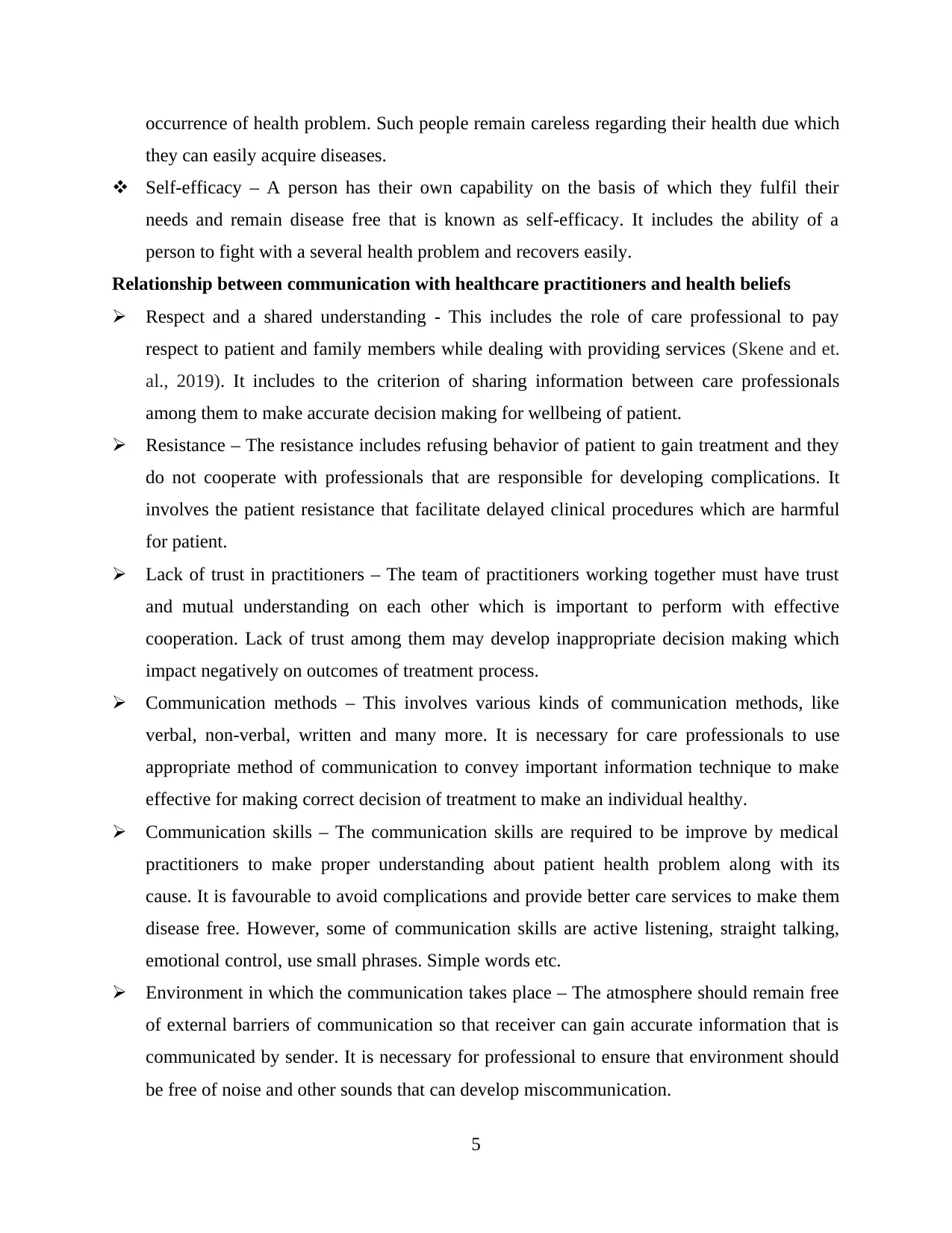
occurrence of health problem. Such people remain careless regarding their health due which
they can easily acquire diseases.
Self-efficacy – A person has their own capability on the basis of which they fulfil their
needs and remain disease free that is known as self-efficacy. It includes the ability of a
person to fight with a several health problem and recovers easily.
Relationship between communication with healthcare practitioners and health beliefs
Respect and a shared understanding - This includes the role of care professional to pay
respect to patient and family members while dealing with providing services (Skene and et.
al., 2019). It includes to the criterion of sharing information between care professionals
among them to make accurate decision making for wellbeing of patient.
Resistance – The resistance includes refusing behavior of patient to gain treatment and they
do not cooperate with professionals that are responsible for developing complications. It
involves the patient resistance that facilitate delayed clinical procedures which are harmful
for patient.
Lack of trust in practitioners – The team of practitioners working together must have trust
and mutual understanding on each other which is important to perform with effective
cooperation. Lack of trust among them may develop inappropriate decision making which
impact negatively on outcomes of treatment process.
Communication methods – This involves various kinds of communication methods, like
verbal, non-verbal, written and many more. It is necessary for care professionals to use
appropriate method of communication to convey important information technique to make
effective for making correct decision of treatment to make an individual healthy.
Communication skills – The communication skills are required to be improve by medical
practitioners to make proper understanding about patient health problem along with its
cause. It is favourable to avoid complications and provide better care services to make them
disease free. However, some of communication skills are active listening, straight talking,
emotional control, use small phrases. Simple words etc.
Environment in which the communication takes place – The atmosphere should remain free
of external barriers of communication so that receiver can gain accurate information that is
communicated by sender. It is necessary for professional to ensure that environment should
be free of noise and other sounds that can develop miscommunication.
5
they can easily acquire diseases.
Self-efficacy – A person has their own capability on the basis of which they fulfil their
needs and remain disease free that is known as self-efficacy. It includes the ability of a
person to fight with a several health problem and recovers easily.
Relationship between communication with healthcare practitioners and health beliefs
Respect and a shared understanding - This includes the role of care professional to pay
respect to patient and family members while dealing with providing services (Skene and et.
al., 2019). It includes to the criterion of sharing information between care professionals
among them to make accurate decision making for wellbeing of patient.
Resistance – The resistance includes refusing behavior of patient to gain treatment and they
do not cooperate with professionals that are responsible for developing complications. It
involves the patient resistance that facilitate delayed clinical procedures which are harmful
for patient.
Lack of trust in practitioners – The team of practitioners working together must have trust
and mutual understanding on each other which is important to perform with effective
cooperation. Lack of trust among them may develop inappropriate decision making which
impact negatively on outcomes of treatment process.
Communication methods – This involves various kinds of communication methods, like
verbal, non-verbal, written and many more. It is necessary for care professionals to use
appropriate method of communication to convey important information technique to make
effective for making correct decision of treatment to make an individual healthy.
Communication skills – The communication skills are required to be improve by medical
practitioners to make proper understanding about patient health problem along with its
cause. It is favourable to avoid complications and provide better care services to make them
disease free. However, some of communication skills are active listening, straight talking,
emotional control, use small phrases. Simple words etc.
Environment in which the communication takes place – The atmosphere should remain free
of external barriers of communication so that receiver can gain accurate information that is
communicated by sender. It is necessary for professional to ensure that environment should
be free of noise and other sounds that can develop miscommunication.
5
Paraphrase This Document
Need a fresh take? Get an instant paraphrase of this document with our AI Paraphraser
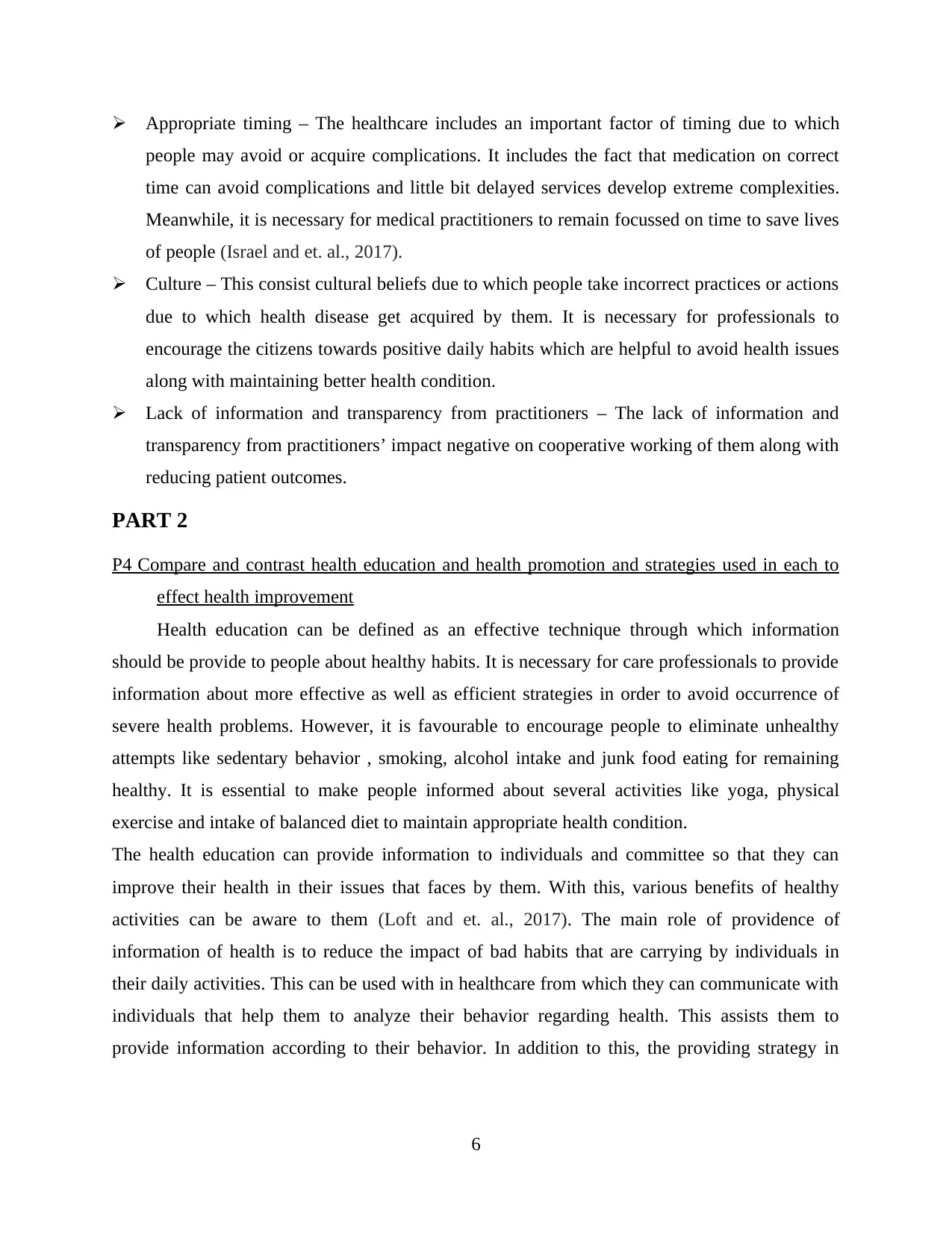
Appropriate timing – The healthcare includes an important factor of timing due to which
people may avoid or acquire complications. It includes the fact that medication on correct
time can avoid complications and little bit delayed services develop extreme complexities.
Meanwhile, it is necessary for medical practitioners to remain focussed on time to save lives
of people (Israel and et. al., 2017).
Culture – This consist cultural beliefs due to which people take incorrect practices or actions
due to which health disease get acquired by them. It is necessary for professionals to
encourage the citizens towards positive daily habits which are helpful to avoid health issues
along with maintaining better health condition.
Lack of information and transparency from practitioners – The lack of information and
transparency from practitioners’ impact negative on cooperative working of them along with
reducing patient outcomes.
PART 2
P4 Compare and contrast health education and health promotion and strategies used in each to
effect health improvement
Health education can be defined as an effective technique through which information
should be provide to people about healthy habits. It is necessary for care professionals to provide
information about more effective as well as efficient strategies in order to avoid occurrence of
severe health problems. However, it is favourable to encourage people to eliminate unhealthy
attempts like sedentary behavior , smoking, alcohol intake and junk food eating for remaining
healthy. It is essential to make people informed about several activities like yoga, physical
exercise and intake of balanced diet to maintain appropriate health condition.
The health education can provide information to individuals and committee so that they can
improve their health in their issues that faces by them. With this, various benefits of healthy
activities can be aware to them (Loft and et. al., 2017). The main role of providence of
information of health is to reduce the impact of bad habits that are carrying by individuals in
their daily activities. This can be used with in healthcare from which they can communicate with
individuals that help them to analyze their behavior regarding health. This assists them to
provide information according to their behavior. In addition to this, the providing strategy in
6
people may avoid or acquire complications. It includes the fact that medication on correct
time can avoid complications and little bit delayed services develop extreme complexities.
Meanwhile, it is necessary for medical practitioners to remain focussed on time to save lives
of people (Israel and et. al., 2017).
Culture – This consist cultural beliefs due to which people take incorrect practices or actions
due to which health disease get acquired by them. It is necessary for professionals to
encourage the citizens towards positive daily habits which are helpful to avoid health issues
along with maintaining better health condition.
Lack of information and transparency from practitioners – The lack of information and
transparency from practitioners’ impact negative on cooperative working of them along with
reducing patient outcomes.
PART 2
P4 Compare and contrast health education and health promotion and strategies used in each to
effect health improvement
Health education can be defined as an effective technique through which information
should be provide to people about healthy habits. It is necessary for care professionals to provide
information about more effective as well as efficient strategies in order to avoid occurrence of
severe health problems. However, it is favourable to encourage people to eliminate unhealthy
attempts like sedentary behavior , smoking, alcohol intake and junk food eating for remaining
healthy. It is essential to make people informed about several activities like yoga, physical
exercise and intake of balanced diet to maintain appropriate health condition.
The health education can provide information to individuals and committee so that they can
improve their health in their issues that faces by them. With this, various benefits of healthy
activities can be aware to them (Loft and et. al., 2017). The main role of providence of
information of health is to reduce the impact of bad habits that are carrying by individuals in
their daily activities. This can be used with in healthcare from which they can communicate with
individuals that help them to analyze their behavior regarding health. This assists them to
provide information according to their behavior. In addition to this, the providing strategy in
6
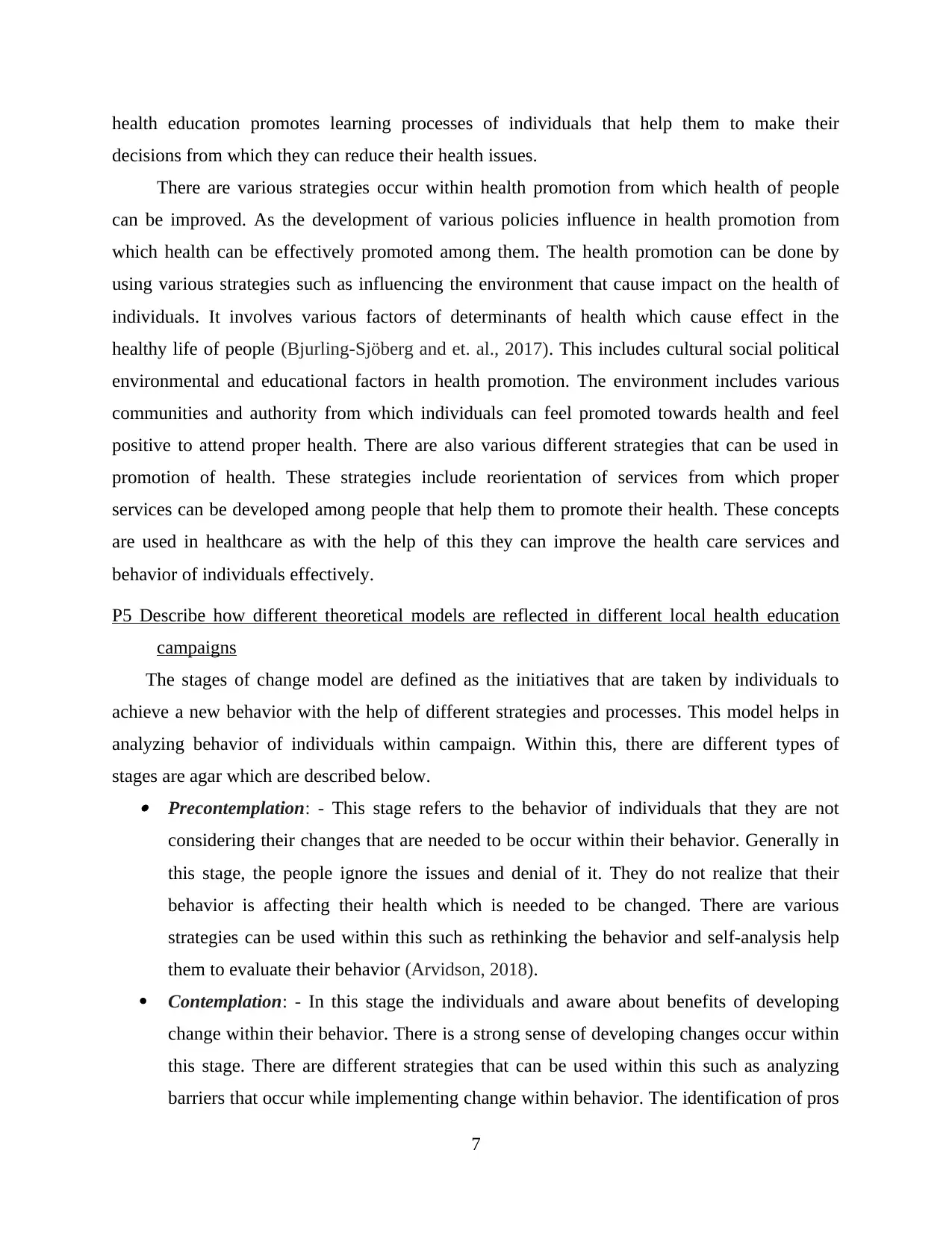
health education promotes learning processes of individuals that help them to make their
decisions from which they can reduce their health issues.
There are various strategies occur within health promotion from which health of people
can be improved. As the development of various policies influence in health promotion from
which health can be effectively promoted among them. The health promotion can be done by
using various strategies such as influencing the environment that cause impact on the health of
individuals. It involves various factors of determinants of health which cause effect in the
healthy life of people (Bjurling-Sjöberg and et. al., 2017). This includes cultural social political
environmental and educational factors in health promotion. The environment includes various
communities and authority from which individuals can feel promoted towards health and feel
positive to attend proper health. There are also various different strategies that can be used in
promotion of health. These strategies include reorientation of services from which proper
services can be developed among people that help them to promote their health. These concepts
are used in healthcare as with the help of this they can improve the health care services and
behavior of individuals effectively.
P5 Describe how different theoretical models are reflected in different local health education
campaigns
The stages of change model are defined as the initiatives that are taken by individuals to
achieve a new behavior with the help of different strategies and processes. This model helps in
analyzing behavior of individuals within campaign. Within this, there are different types of
stages are agar which are described below. Precontemplation: - This stage refers to the behavior of individuals that they are not
considering their changes that are needed to be occur within their behavior. Generally in
this stage, the people ignore the issues and denial of it. They do not realize that their
behavior is affecting their health which is needed to be changed. There are various
strategies can be used within this such as rethinking the behavior and self-analysis help
them to evaluate their behavior (Arvidson, 2018).
Contemplation: - In this stage the individuals and aware about benefits of developing
change within their behavior. There is a strong sense of developing changes occur within
this stage. There are different strategies that can be used within this such as analyzing
barriers that occur while implementing change within behavior. The identification of pros
7
decisions from which they can reduce their health issues.
There are various strategies occur within health promotion from which health of people
can be improved. As the development of various policies influence in health promotion from
which health can be effectively promoted among them. The health promotion can be done by
using various strategies such as influencing the environment that cause impact on the health of
individuals. It involves various factors of determinants of health which cause effect in the
healthy life of people (Bjurling-Sjöberg and et. al., 2017). This includes cultural social political
environmental and educational factors in health promotion. The environment includes various
communities and authority from which individuals can feel promoted towards health and feel
positive to attend proper health. There are also various different strategies that can be used in
promotion of health. These strategies include reorientation of services from which proper
services can be developed among people that help them to promote their health. These concepts
are used in healthcare as with the help of this they can improve the health care services and
behavior of individuals effectively.
P5 Describe how different theoretical models are reflected in different local health education
campaigns
The stages of change model are defined as the initiatives that are taken by individuals to
achieve a new behavior with the help of different strategies and processes. This model helps in
analyzing behavior of individuals within campaign. Within this, there are different types of
stages are agar which are described below. Precontemplation: - This stage refers to the behavior of individuals that they are not
considering their changes that are needed to be occur within their behavior. Generally in
this stage, the people ignore the issues and denial of it. They do not realize that their
behavior is affecting their health which is needed to be changed. There are various
strategies can be used within this such as rethinking the behavior and self-analysis help
them to evaluate their behavior (Arvidson, 2018).
Contemplation: - In this stage the individuals and aware about benefits of developing
change within their behavior. There is a strong sense of developing changes occur within
this stage. There are different strategies that can be used within this such as analyzing
barriers that occur while implementing change within behavior. The identification of pros
7
⊘ This is a preview!⊘
Do you want full access?
Subscribe today to unlock all pages.

Trusted by 1+ million students worldwide
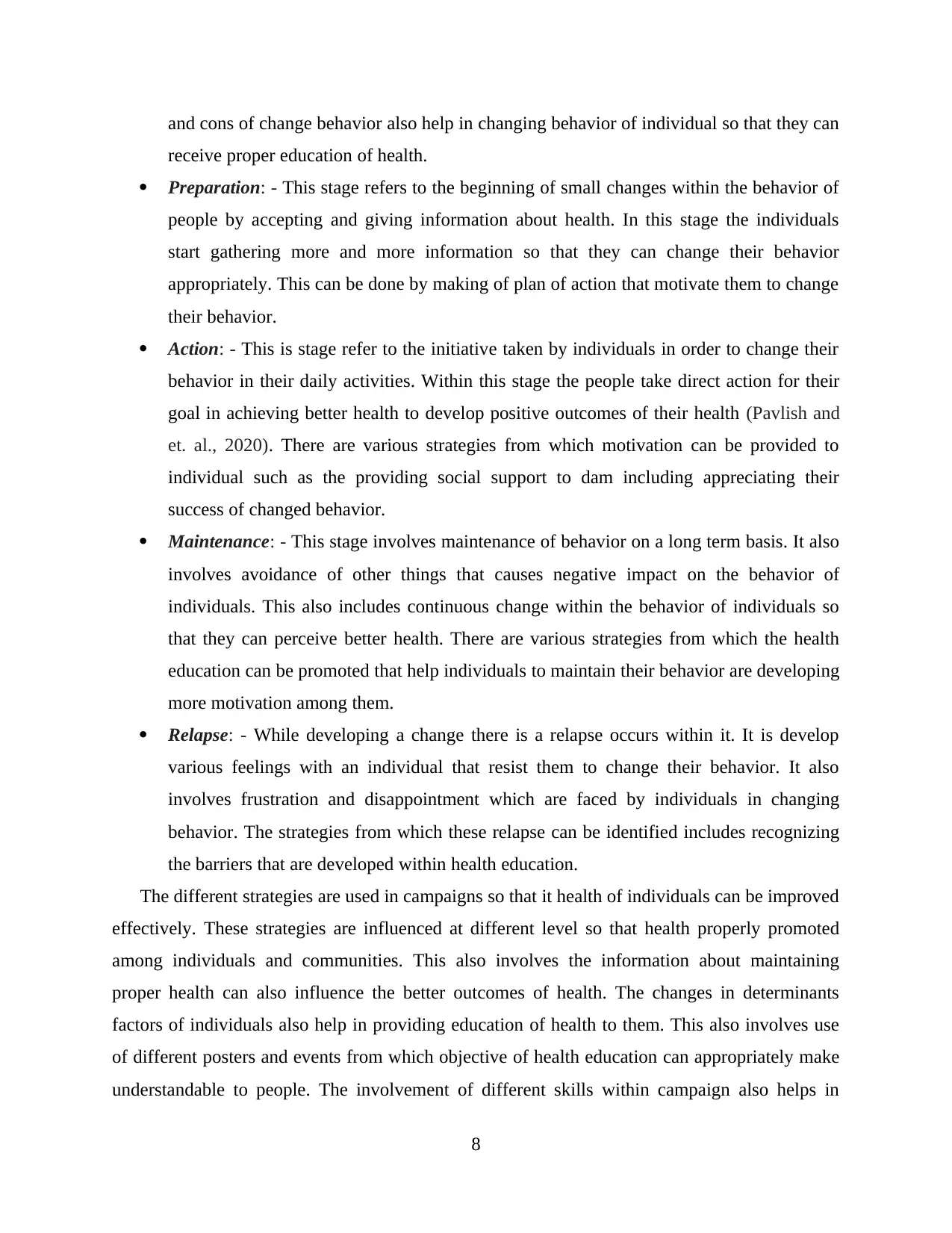
and cons of change behavior also help in changing behavior of individual so that they can
receive proper education of health.
Preparation: - This stage refers to the beginning of small changes within the behavior of
people by accepting and giving information about health. In this stage the individuals
start gathering more and more information so that they can change their behavior
appropriately. This can be done by making of plan of action that motivate them to change
their behavior.
Action: - This is stage refer to the initiative taken by individuals in order to change their
behavior in their daily activities. Within this stage the people take direct action for their
goal in achieving better health to develop positive outcomes of their health (Pavlish and
et. al., 2020). There are various strategies from which motivation can be provided to
individual such as the providing social support to dam including appreciating their
success of changed behavior.
Maintenance: - This stage involves maintenance of behavior on a long term basis. It also
involves avoidance of other things that causes negative impact on the behavior of
individuals. This also includes continuous change within the behavior of individuals so
that they can perceive better health. There are various strategies from which the health
education can be promoted that help individuals to maintain their behavior are developing
more motivation among them.
Relapse: - While developing a change there is a relapse occurs within it. It is develop
various feelings with an individual that resist them to change their behavior. It also
involves frustration and disappointment which are faced by individuals in changing
behavior. The strategies from which these relapse can be identified includes recognizing
the barriers that are developed within health education.
The different strategies are used in campaigns so that it health of individuals can be improved
effectively. These strategies are influenced at different level so that health properly promoted
among individuals and communities. This also involves the information about maintaining
proper health can also influence the better outcomes of health. The changes in determinants
factors of individuals also help in providing education of health to them. This also involves use
of different posters and events from which objective of health education can appropriately make
understandable to people. The involvement of different skills within campaign also helps in
8
receive proper education of health.
Preparation: - This stage refers to the beginning of small changes within the behavior of
people by accepting and giving information about health. In this stage the individuals
start gathering more and more information so that they can change their behavior
appropriately. This can be done by making of plan of action that motivate them to change
their behavior.
Action: - This is stage refer to the initiative taken by individuals in order to change their
behavior in their daily activities. Within this stage the people take direct action for their
goal in achieving better health to develop positive outcomes of their health (Pavlish and
et. al., 2020). There are various strategies from which motivation can be provided to
individual such as the providing social support to dam including appreciating their
success of changed behavior.
Maintenance: - This stage involves maintenance of behavior on a long term basis. It also
involves avoidance of other things that causes negative impact on the behavior of
individuals. This also includes continuous change within the behavior of individuals so
that they can perceive better health. There are various strategies from which the health
education can be promoted that help individuals to maintain their behavior are developing
more motivation among them.
Relapse: - While developing a change there is a relapse occurs within it. It is develop
various feelings with an individual that resist them to change their behavior. It also
involves frustration and disappointment which are faced by individuals in changing
behavior. The strategies from which these relapse can be identified includes recognizing
the barriers that are developed within health education.
The different strategies are used in campaigns so that it health of individuals can be improved
effectively. These strategies are influenced at different level so that health properly promoted
among individuals and communities. This also involves the information about maintaining
proper health can also influence the better outcomes of health. The changes in determinants
factors of individuals also help in providing education of health to them. This also involves use
of different posters and events from which objective of health education can appropriately make
understandable to people. The involvement of different skills within campaign also helps in
8
Paraphrase This Document
Need a fresh take? Get an instant paraphrase of this document with our AI Paraphraser
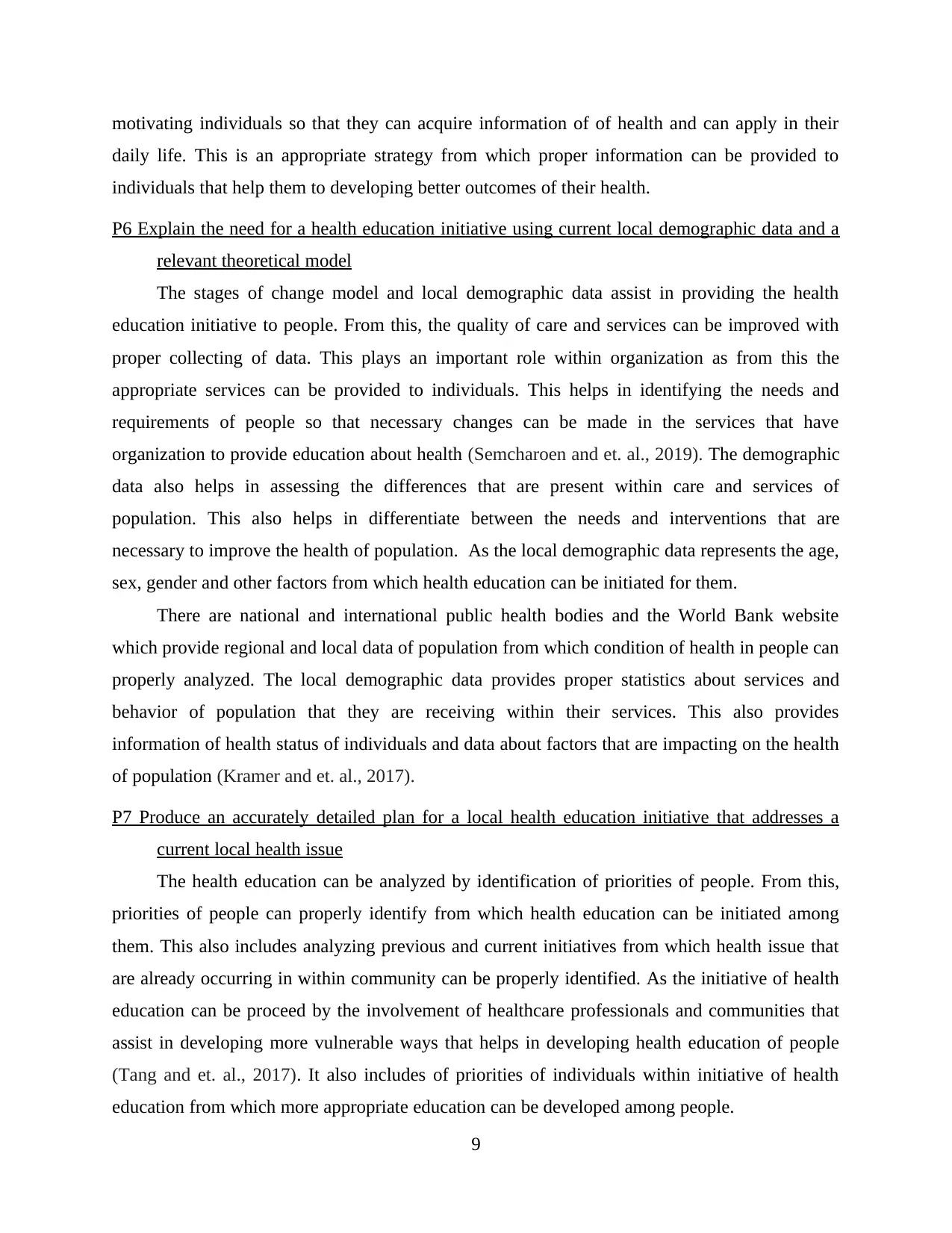
motivating individuals so that they can acquire information of of health and can apply in their
daily life. This is an appropriate strategy from which proper information can be provided to
individuals that help them to developing better outcomes of their health.
P6 Explain the need for a health education initiative using current local demographic data and a
relevant theoretical model
The stages of change model and local demographic data assist in providing the health
education initiative to people. From this, the quality of care and services can be improved with
proper collecting of data. This plays an important role within organization as from this the
appropriate services can be provided to individuals. This helps in identifying the needs and
requirements of people so that necessary changes can be made in the services that have
organization to provide education about health (Semcharoen and et. al., 2019). The demographic
data also helps in assessing the differences that are present within care and services of
population. This also helps in differentiate between the needs and interventions that are
necessary to improve the health of population. As the local demographic data represents the age,
sex, gender and other factors from which health education can be initiated for them.
There are national and international public health bodies and the World Bank website
which provide regional and local data of population from which condition of health in people can
properly analyzed. The local demographic data provides proper statistics about services and
behavior of population that they are receiving within their services. This also provides
information of health status of individuals and data about factors that are impacting on the health
of population (Kramer and et. al., 2017).
P7 Produce an accurately detailed plan for a local health education initiative that addresses a
current local health issue
The health education can be analyzed by identification of priorities of people. From this,
priorities of people can properly identify from which health education can be initiated among
them. This also includes analyzing previous and current initiatives from which health issue that
are already occurring in within community can be properly identified. As the initiative of health
education can be proceed by the involvement of healthcare professionals and communities that
assist in developing more vulnerable ways that helps in developing health education of people
(Tang and et. al., 2017). It also includes of priorities of individuals within initiative of health
education from which more appropriate education can be developed among people.
9
daily life. This is an appropriate strategy from which proper information can be provided to
individuals that help them to developing better outcomes of their health.
P6 Explain the need for a health education initiative using current local demographic data and a
relevant theoretical model
The stages of change model and local demographic data assist in providing the health
education initiative to people. From this, the quality of care and services can be improved with
proper collecting of data. This plays an important role within organization as from this the
appropriate services can be provided to individuals. This helps in identifying the needs and
requirements of people so that necessary changes can be made in the services that have
organization to provide education about health (Semcharoen and et. al., 2019). The demographic
data also helps in assessing the differences that are present within care and services of
population. This also helps in differentiate between the needs and interventions that are
necessary to improve the health of population. As the local demographic data represents the age,
sex, gender and other factors from which health education can be initiated for them.
There are national and international public health bodies and the World Bank website
which provide regional and local data of population from which condition of health in people can
properly analyzed. The local demographic data provides proper statistics about services and
behavior of population that they are receiving within their services. This also provides
information of health status of individuals and data about factors that are impacting on the health
of population (Kramer and et. al., 2017).
P7 Produce an accurately detailed plan for a local health education initiative that addresses a
current local health issue
The health education can be analyzed by identification of priorities of people. From this,
priorities of people can properly identify from which health education can be initiated among
them. This also includes analyzing previous and current initiatives from which health issue that
are already occurring in within community can be properly identified. As the initiative of health
education can be proceed by the involvement of healthcare professionals and communities that
assist in developing more vulnerable ways that helps in developing health education of people
(Tang and et. al., 2017). It also includes of priorities of individuals within initiative of health
education from which more appropriate education can be developed among people.
9
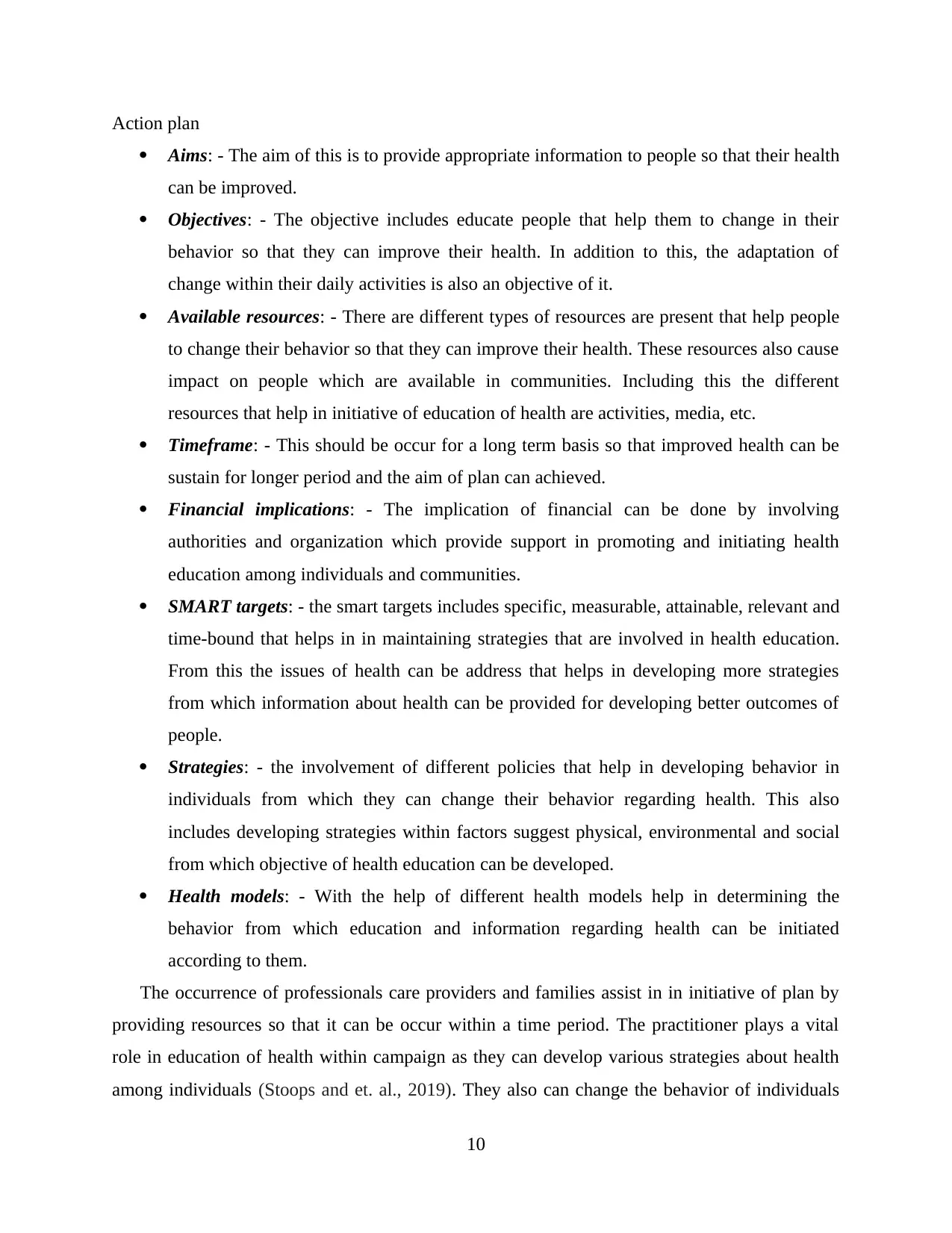
Action plan
Aims: - The aim of this is to provide appropriate information to people so that their health
can be improved.
Objectives: - The objective includes educate people that help them to change in their
behavior so that they can improve their health. In addition to this, the adaptation of
change within their daily activities is also an objective of it.
Available resources: - There are different types of resources are present that help people
to change their behavior so that they can improve their health. These resources also cause
impact on people which are available in communities. Including this the different
resources that help in initiative of education of health are activities, media, etc.
Timeframe: - This should be occur for a long term basis so that improved health can be
sustain for longer period and the aim of plan can achieved.
Financial implications: - The implication of financial can be done by involving
authorities and organization which provide support in promoting and initiating health
education among individuals and communities.
SMART targets: - the smart targets includes specific, measurable, attainable, relevant and
time-bound that helps in in maintaining strategies that are involved in health education.
From this the issues of health can be address that helps in developing more strategies
from which information about health can be provided for developing better outcomes of
people.
Strategies: - the involvement of different policies that help in developing behavior in
individuals from which they can change their behavior regarding health. This also
includes developing strategies within factors suggest physical, environmental and social
from which objective of health education can be developed.
Health models: - With the help of different health models help in determining the
behavior from which education and information regarding health can be initiated
according to them.
The occurrence of professionals care providers and families assist in in initiative of plan by
providing resources so that it can be occur within a time period. The practitioner plays a vital
role in education of health within campaign as they can develop various strategies about health
among individuals (Stoops and et. al., 2019). They also can change the behavior of individuals
10
Aims: - The aim of this is to provide appropriate information to people so that their health
can be improved.
Objectives: - The objective includes educate people that help them to change in their
behavior so that they can improve their health. In addition to this, the adaptation of
change within their daily activities is also an objective of it.
Available resources: - There are different types of resources are present that help people
to change their behavior so that they can improve their health. These resources also cause
impact on people which are available in communities. Including this the different
resources that help in initiative of education of health are activities, media, etc.
Timeframe: - This should be occur for a long term basis so that improved health can be
sustain for longer period and the aim of plan can achieved.
Financial implications: - The implication of financial can be done by involving
authorities and organization which provide support in promoting and initiating health
education among individuals and communities.
SMART targets: - the smart targets includes specific, measurable, attainable, relevant and
time-bound that helps in in maintaining strategies that are involved in health education.
From this the issues of health can be address that helps in developing more strategies
from which information about health can be provided for developing better outcomes of
people.
Strategies: - the involvement of different policies that help in developing behavior in
individuals from which they can change their behavior regarding health. This also
includes developing strategies within factors suggest physical, environmental and social
from which objective of health education can be developed.
Health models: - With the help of different health models help in determining the
behavior from which education and information regarding health can be initiated
according to them.
The occurrence of professionals care providers and families assist in in initiative of plan by
providing resources so that it can be occur within a time period. The practitioner plays a vital
role in education of health within campaign as they can develop various strategies about health
among individuals (Stoops and et. al., 2019). They also can change the behavior of individuals
10
⊘ This is a preview!⊘
Do you want full access?
Subscribe today to unlock all pages.

Trusted by 1+ million students worldwide
1 out of 15
Related Documents
Your All-in-One AI-Powered Toolkit for Academic Success.
+13062052269
info@desklib.com
Available 24*7 on WhatsApp / Email
![[object Object]](/_next/static/media/star-bottom.7253800d.svg)
Unlock your academic potential
Copyright © 2020–2025 A2Z Services. All Rights Reserved. Developed and managed by ZUCOL.




